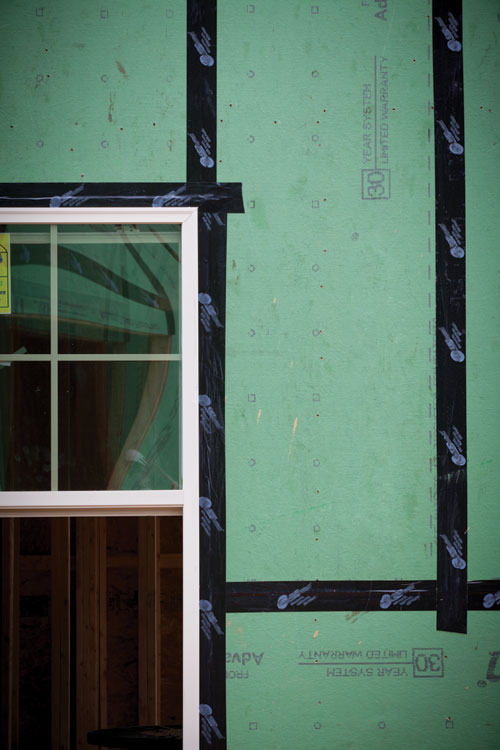Acrylic Flashing Tape Keeps It Together
Learning Objectives:
- Name various types of flashing as they relate to building soundness.
- Identify and compare three types of construction tapes that are commonly used for flashing around windows, doors, and penetrations.
- Discuss the importance of an air barrier system in building integrity.
- Identify testing standards for self-adhered flashing tapes as they promote safety of buildings and occupants.
Credits:
Builders have long battled the intrusion of unwanted moisture and air into their structures. Water of any kind is a prime factor in building damage, and can cause mold growth, decay, and corrosion responsible for both health and structural durability issues—that goes for both gross water leakage into the structure as well as for infiltrated air through the building envelope which can result in the condensation of moisture. Every year billions of dollars are spent combating moisture intrusion and rectifying its harmful effects. When it comes to preventing moisture or bulk water into a building, flashing is on the front lines. Placed around windows, doors, and other penetrations, flashing protects the building envelope and is a prime defense against unwanted moisture penetration and its consequences.
How well flashing accomplishes its intended mission depends on the material used and its proper placement and installation. This article will offer a comparative discussion of various types of flashings, with an emphasis on the incorporation of acrylic tapes. Tests and standards for determining durable, reliable, self-adhered flashing materials will also be discussed, as well as the role these materials play in creating effective air barrier systems.
Flashing—The Basics
A thin continuous piece of impervious material applied to prevent the passage of water into a structure from an angle or joint, flashing is a key protector against leaks and water damage. Flashing, which may be either exposed or concealed, has to be carefully applied so that water is actually directed away from the structure and not inside. Sometimes flashing is improperly installed by inexperienced laborers who do not understand its purpose, which can result in severe water intrusion and mold. The service life of flashing can determine the service life of an entire building. There are several types of flashing available.
Rigid Flashings/Sheet Metal
Plastic sheets or sheet metal, generally aluminum, copper, painted galvanized steel, stainless steel, lead or lead-coated copper, can also be used as flashing materials. Sheet metal can be molded to fit a space, though expansion joints should be provided to prevent deformation of the metal. The selected metal should not stain or be stained by adjacent materials or react chemically with them. Plastics may cost less than other materials, and can be tough, flexible, and durable. Many plastic products are made of polyvinyl chlorides, which may deteriorate considerably when exposed to ultraviolet light, and consequently should be concealed.
 |
Acrylic flashing tape enables an airtight building. Photo courtesy of Huber Engineered Woods |
Self-Adhered Flashing
Today, many builders use pressure-sensitive membranes to flash around windows, doors, and other penetrations. These self-adhered materials will stick to a surface with applied pressure without the need for any type of solvent, heat, or water for activation. Generally these membranes consist of pressure-sensitive adhesives that are coated onto paper, plastic, cloth, foil, or other backing material. In some self-adhered flashing, a removable liner acts to protect the adhesive. These so-called peel and stick membranes are typically 4 to 12 inches wide and facilitate creation of a continuous barrier around windows and doors in wood frame construction. Some tapes used for flashing purposes can also be used to properly seal the seams in sheathing to prevent water entry through these and other penetrations. Pressure-sensitive tapes are bendable, and consequently able to achieve a more accurate fit around windows, doors, and penetrations. If pressed firmly into place, most pressure-sensitive tapes bond well to a range of materials from wood-based products to metal, and accommodate movement from expansion and contraction. Correctly installed flashing tapes can provide long-lasting waterproof protection.
Generally speaking, self-adhered tapes offer several benefits over other types of membrane flashing. Installation is faster, with no cure time or clamping required, or the need for special tools to brush on adhesive material. Greater efficiencies translate to a more cost-effective process, with less time and resources expended in setup, installation, and clean up, and fewer products such as tubes and buckets to dispose of. Tapes also help to raise a building's green quotient. The absence of volatile organic compounds (VOCs) means less exposure to toxic fumes, along with minimization or outright avoidance of toxic landfill contributions from residual liquid adhesive waste. Clean up necessitating hazardous solvents is eliminated as is toxic outgassing during cure time.









